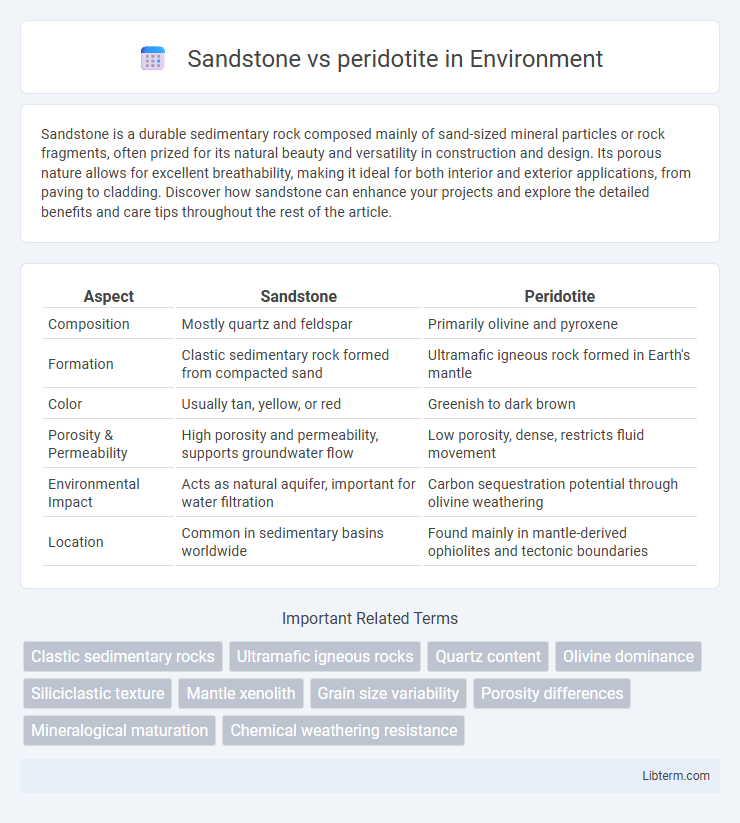Sandstone is a durable sedimentary rock composed mainly of sand-sized mineral particles or rock fragments, often prized for its natural beauty and versatility in construction and design. Its porous nature allows for excellent breathability, making it ideal for both interior and exterior applications, from paving to cladding. Discover how sandstone can enhance your projects and explore the detailed benefits and care tips throughout the rest of the article.
Table of Comparison
| Aspect | Sandstone | Peridotite |
|---|---|---|
| Composition | Mostly quartz and feldspar | Primarily olivine and pyroxene |
| Formation | Clastic sedimentary rock formed from compacted sand | Ultramafic igneous rock formed in Earth's mantle |
| Color | Usually tan, yellow, or red | Greenish to dark brown |
| Porosity & Permeability | High porosity and permeability, supports groundwater flow | Low porosity, dense, restricts fluid movement |
| Environmental Impact | Acts as natural aquifer, important for water filtration | Carbon sequestration potential through olivine weathering |
| Location | Common in sedimentary basins worldwide | Found mainly in mantle-derived ophiolites and tectonic boundaries |
Introduction to Sandstone and Peridotite
Sandstone is a clastic sedimentary rock primarily composed of sand-sized mineral particles, often quartz or feldspar, cemented by silica, calcium carbonate, or iron oxides. Peridotite is an ultramafic igneous rock mainly composed of olivine and pyroxenes, originating in the Earth's mantle and serving as a key source rock for basaltic magmas. The contrasting formation processes--sedimentary for sandstone and mantle-derived magmatic for peridotite--result in distinct mineralogical compositions and geological significance.
Geological Formation Processes
Sandstone forms through the compaction and cementation of sand-sized mineral particles, primarily quartz, deposited by water or wind in sedimentary environments such as rivers, beaches, and deserts. In contrast, peridotite originates from the Earth's mantle and crystallizes from magma under high-pressure conditions, predominantly composed of olivine and pyroxene minerals. The geological formation processes of sandstone involve sedimentation and lithification at low temperatures and pressures, while peridotite results from ultramafic igneous activity deep within the lithosphere.
Mineral Composition Comparison
Sandstone primarily consists of quartz, feldspar, and rock fragments, making it a clastic sedimentary rock with a high silica content. Peridotite is an ultramafic igneous rock dominated by olivine and pyroxene minerals, containing very low silica but abundant magnesium and iron. The stark contrast in mineral composition reflects their different origins: sandstone forms through sediment deposition and lithification, whereas peridotite originates from the Earth's mantle.
Color and Texture Differences
Sandstone typically exhibits a range of warm colors such as tan, yellow, red, or brown due to its quartz and feldspar mineral content, with a grainy, gritty texture resulting from its sand-sized particles cemented together. In contrast, peridotite is usually dark green to black because of its high olivine and pyroxene content, featuring a coarse-grained, phaneritic texture where individual mineral crystals are visibly interlocked. The color and texture differences between these two rocks are primarily influenced by their mineral composition and formation processes.
Physical Properties and Durability
Sandstone is a sedimentary rock composed mainly of quartz and feldspar, characterized by moderate hardness (6-7 on Mohs scale) and good porosity, making it relatively permeable but susceptible to weathering and erosion over time. Peridotite, an ultramafic igneous rock rich in olivine and pyroxene, exhibits higher density and hardness (around 6-7 on Mohs scale) with extreme durability and resistance to chemical weathering, often forming the Earth's mantle's foundation. The dense, coarse-grained texture of peridotite contributes to its superior structural strength and long-term stability compared to the more porous, less durable sandstone.
Common Locations and Occurrences
Sandstone is commonly found in sedimentary basins such as the Colorado Plateau and the Sahara Desert, forming in environments like riverbeds, beaches, and deserts where sand accumulates and lithifies. Peridotite predominantly occurs in the Earth's upper mantle and is commonly exposed at tectonic plate boundaries, especially in ophiolite complexes like those in the Oman Mountains and the Josephine Ophiolite of California. Sandstone layers are widespread and accessible at the Earth's surface, whereas peridotite is typically found in deeper geological settings brought to the surface through tectonic uplift or obduction.
Industrial and Commercial Uses
Sandstone is widely used in construction, landscaping, and as a raw material for cement due to its durability and ease of shaping. Peridotite, rich in olivine, is primarily exploited for extracting magnesium and as a potential source for carbon sequestration technologies. Industrial applications of peridotite also include refractory materials and soil conditioning in agriculture.
Weathering and Erosion Resistance
Sandstone, composed primarily of quartz grains cemented together, exhibits moderate resistance to weathering and erosion due to its relatively porous and granular structure. Peridotite, an ultramafic igneous rock rich in olivine and pyroxene, demonstrates higher chemical weathering rates but greater physical durability, often altering to serpentine through hydrothermal processes. The contrasting mineral compositions influence their susceptibility, with sandstone prone to mechanical breakdown while peridotite undergoes significant chemical alteration yet maintains structural strength.
Role in Earth’s Geology and Ecosystems
Sandstone, a sedimentary rock composed mainly of quartz and feldspar, plays a crucial role in Earth's geology by forming extensive aquifers and serving as reservoirs for groundwater and hydrocarbons. Peridotite, an ultramafic igneous rock rich in olivine and pyroxene, is a primary component of the Earth's mantle and influences tectonic processes and mantle convection. Sandstone ecosystems support diverse terrestrial habitats due to their porosity and nutrient content, while peridotite weathers into soils that contribute essential minerals influencing plant growth and carbon sequestration.
Summary: Choosing Between Sandstone and Peridotite
Sandstone is a sedimentary rock composed mainly of quartz or feldspar, characterized by its porosity and suitability for construction and landscaping. Peridotite is an ultramafic igneous rock rich in olivine and pyroxene, known for its high density and significance in mantle geology and carbon sequestration studies. Selection between sandstone and peridotite depends on application needs, with sandstone favored for durability and aesthetics, while peridotite is chosen for geological and environmental purposes.
Sandstone Infographic

 libterm.com
libterm.com